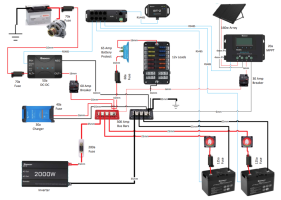Here is how I propose to wire my van. If anyone has a moment to take a look I would be very grateful if you spot I have made an error. Especially with cable sizes as there seems to be such variation in the advice.
I have sized assuming the only two long run are the connection from the alternator to the DC-DC converter and the wires from the roof solar however I have two captain seats so I may have to adjust when the batteries turn up if I can not fit everything.
I will add the 240v circuits and 12v loads in a later version but they are not expected to exceed 60 amps other than loads through the 2000w inverter which will include 1800w induction, 1500w kettle or similar obviously not at the same time.

I have sized assuming the only two long run are the connection from the alternator to the DC-DC converter and the wires from the roof solar however I have two captain seats so I may have to adjust when the batteries turn up if I can not fit everything.
I will add the 240v circuits and 12v loads in a later version but they are not expected to exceed 60 amps other than loads through the 2000w inverter which will include 1800w induction, 1500w kettle or similar obviously not at the same time.

